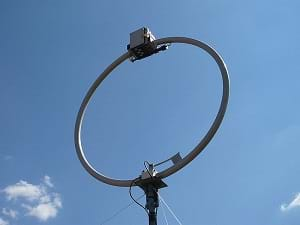
Summary
A class demo introduces students to the force between two current carrying loops, comparing the attraction and repulsion between the loops to that between two magnets. After a lecture on Ampere's law (including some sample cases and problems), students begin to use the concepts to calculate the magnetic field around a loop. This is applied to determine the magnetic field of a toroid, imagining a toroid as a looped solenoid. Students use Ampere's law to solve some homework problems.Engineering Connection
Understanding Ampere's law enables engineers to calculate the magnetic field around a loop, which is useful in studying the magnetic field produced by MRI magnets. In addition to calculating the magnetic field, engineers use Ampere's law to determine the amount of current and voltage needed to create a functioning circuit board to perform desired tasks.
Learning Objectives
After this lesson, students should be able to
- Apply Ampere's law to calculate magnetic fields in symmetric situations.
- Describe the magnetic field of a toroid.
Educational Standards
Each TeachEngineering lesson or activity is correlated to one or more K-12 science,
technology, engineering or math (STEM) educational standards.
All 100,000+ K-12 STEM standards covered in TeachEngineering are collected, maintained and packaged by the Achievement Standards Network (ASN),
a project of D2L (www.achievementstandards.org).
In the ASN, standards are hierarchically structured: first by source; e.g., by state; within source by type; e.g., science or mathematics;
within type by subtype, then by grade, etc.
Each TeachEngineering lesson or activity is correlated to one or more K-12 science, technology, engineering or math (STEM) educational standards.
All 100,000+ K-12 STEM standards covered in TeachEngineering are collected, maintained and packaged by the Achievement Standards Network (ASN), a project of D2L (www.achievementstandards.org).
In the ASN, standards are hierarchically structured: first by source; e.g., by state; within source by type; e.g., science or mathematics; within type by subtype, then by grade, etc.
NGSS: Next Generation Science Standards - Science
| NGSS Performance Expectation | ||
|---|---|---|
|
HS-PS3-2. Develop and use models to illustrate that energy at the macroscopic scale can be accounted for as either motions of particles or energy stored in fields. (Grades 9 - 12) Do you agree with this alignment? |
||
| Click to view other curriculum aligned to this Performance Expectation | ||
| This lesson focuses on the following Three Dimensional Learning aspects of NGSS: | ||
| Science & Engineering Practices | Disciplinary Core Ideas | Crosscutting Concepts |
| Develop and use a model based on evidence to illustrate the relationships between systems or between components of a system. Alignment agreement: | Energy is a quantitative property of a system that depends on the motion and interactions of matter and radiation within that system. That there is a single quantity called energy is due to the fact that a system's total energy is conserved, even as, within the system, energy is continually transferred from one object to another and between its various possible forms. Alignment agreement: At the macroscopic scale, energy manifests itself in multiple ways, such as in motion, sound, light, and thermal energy.Alignment agreement: These relationships are better understood at the microscopic scale, at which all of the different manifestations of energy can be modeled as a combination of energy associated with the motion of particles and energy associated with the configuration (relative position of the particles). In some cases the relative position energy can be thought of as stored in fields (which mediate interactions between particles). This last concept includes radiation, a phenomenon in which energy stored in fields moves across space.Alignment agreement: | Energy cannot be created or destroyed—it only moves between one place and another place, between objects and/or fields, or between systems. Alignment agreement: |
Common Core State Standards - Math
-
Apply concepts of density based on area and volume in modeling situations (e.g., persons per square mile, BTUs per cubic foot).
(Grades
9 -
12)
More Details
Do you agree with this alignment?
International Technology and Engineering Educators Association - Technology
-
Energy can be grouped into major forms: thermal, radiant, electrical, mechanical, chemical, nuclear, and others.
(Grades
9 -
12)
More Details
Do you agree with this alignment?
-
Assess how similarities and differences among scientific, mathematical, engineering, and technological knowledge and skills contributed to the design of a product or system.
(Grades
9 -
12)
More Details
Do you agree with this alignment?
State Standards
National Science Education Standards - Science
-
Results of scientific inquiry--new knowledge and methods--emerge from different types of investigations and public communication among scientists. In communicating and defending the results of scientific inquiry, arguments must be logical and demonstrate connections between natural phenomena, investigations, and the historical body of scientific knowledge. In addition, the methods and procedures that scientists used to obtain evidence must be clearly reported to enhance opportunities for further investigation.
(Grades
9 -
12)
More Details
Do you agree with this alignment?
Worksheets and Attachments
Visit [www.teachengineering.org/lessons/view/van_mri_lesson_7] to print or download.Introduction/Motivation
In order to solve the MRI safety challenge (of this unit), we need to understand and measure the magnetic field given by current loops. Engineers continue to study magnetic fields, and they work with other engineers to aim to design more powerful MRI machines around 7 Tesla, compared to the conventional 1.5 Tesla used in most imaging facilities.
Class Demo: Force between Two Current Loops
Objective: The demo goal is to show the force between two current carrying loops. The attraction and repulsion between the loops closely resembles the force between magnets and can help students begin to visualize the force between current loops as related to a current within the solid or to the magnetic moment.
Materials:
- 2 small-diameter coil
- 2 30W or higher 5V DC power supply
- 2 lab stands
- 1 thin str aluminum foil
- 4 wires with alligator clip leads
- 1 roll tape
*This demo was tested with a 2-inch diameter coil of 100 turns using 20 gauge magnet wire held together with duct tape.
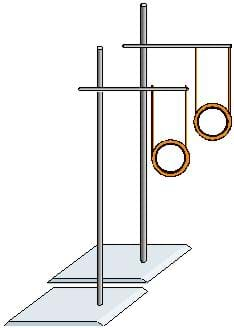
Before presenting the demo, pose the problem of two short segments of wire aligned in a parallel fashion and have students determine the direction of the magnetic field in each segment produced by the other segment. Then have them determine the direction of the magnetic force on each segment. Then consider many of these segments forming a loop in which each segment of the loop is attracted to the corresponding segment on the other loop. Have the students determine the magnetic moment vector of each coil to conclude that loops with parallel magnetic moments will attract.
Set up the demonstration as shown Figure A. Connect each loop to its own power supply, but do not complete the circuit until you are ready to start the demonstration as the wires may overheat. Do not leave the circuits connected for more than a few seconds. Momentarily complete the circuit to both coils and watch them attract. Reverse the current in one of the loops to see them repel.
Lesson Background and Concepts for Teachers
Legacy Cycle Information
This lesson fits into the research and revise phase of the legacy cycle during which students are provided with additional information enabling them to revise their initial ideas for solving the challenge. The research aspect consists of a class demonstration on the force between two current loops and a lecture on Ampere's law and its applications.
Ampere's Law
Although the total magnetic flux through a closed surface must be zero, the sum of the magnetic field around a closed loop does not have to be zero. More specifically, if a closed loop is imagined in space, we can create a vector at each tiny segment called dl pointing in the direction of the loop with a magnitude equal to the length of the segment. Then we will look at the magnetic field at that point, and take the dot product 

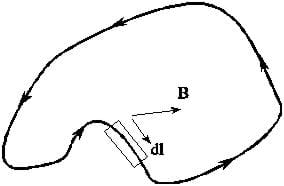
As you might imagine, the magnetic field around a loop would be greater if a wire carrying current was passing through the interior of the loop. In fact, the exact value of the field around the loop is 
This result is named Ampere's law, after its discoverer.
Much like Gauss law, it is useful in determining the magnitude of the magnetic field in highly symmetric situations.
Example: Determine the magnetic field outside of an infinitely long straight wire.
Solution: Consider a closed circular loop of radius R around the wire centered on the axis of the wire, as shown in Figure C. Note that the diagram is rotationally symmetric, so that the magnetic field must have a constant magnitude around the loop.
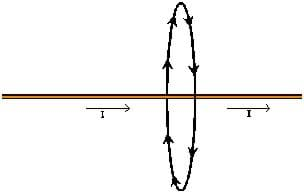
Thus, 
Now by Ampere's law,

This result is in agreement with the Biot-Savart law. Note that this would appear to work for a finite segment of wire and give the same result, contradicting the result from the Biot-Savart law saying that 
Experimentally, the Biot-Savart law has been shown to be correct. This discrepancy can be understood by realizing that the segment of wire must be part of a larger circuit, breaking the symmetry and invalidating the use of Ampere's law, or that the current must be a non-steady flow from one conductor to another. From this, we can surmise that Ampere's law must be valid only for steady-state currents.
Toroid
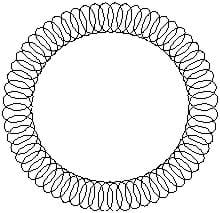
A toroid is basically a solenoid that is bent into a circle, as shown in Figure D. This doughnut-shaped figure has an inner radius a, an outer radius b, a current I, and a total number of turns N. To determine the magnetic field using amperes law, imagine a circular loop of radius r sharing a center with the toroid in the plane of the toroid.
Case 1: r < a
If r < a, then no current is passing through the loop, so 
Since the diagram possesses rotational symmetry, the magnetic field must have equal magnitude anywhere along the loop, so B = 0 everywhere inside the inner radius.
Case 2: a < r < b
In this case, each turn passes through the loop in one direction, as shown in the cross sectional view in Figure E.
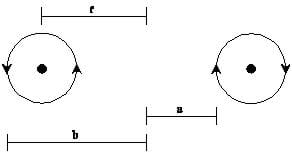

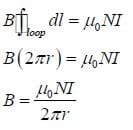
Case 3: r > b
In this case, for each inner turn passing current I through the loop in one direction, there is an outer turn passing current I through the loop in the other direction, so that the total current through the Amperian loop is zero, thus B = 0 everywhere outside the outer radius.
Vocabulary/Definitions
toroid: A surface generated by the revolution of any closed plane curve or contour about an axis lying in its plane.
Assessment
Homework: Assign students to complete the Ampere's Law Homework questions to assess their progress in comprehending the concepts.
Subscribe
Get the inside scoop on all things TeachEngineering such as new site features, curriculum updates, video releases, and more by signing up for our newsletter!More Curriculum Like This

Students induce EMF in a coil of wire using magnetic fields. Students review the cross product with respect to magnetic force and introduce magnetic flux, Faraday's law of Induction, Lenz's law, eddy currents, motional EMF and Induced EMF.

Beginning with a class demo, students are prompted to consider how current generates a magnetic field, and the direction of the field that is generated. Via a lecture, students learn Biot-Savart's law (and work some sample problems) in order to calculate, most simply, the magnetic field produced in ...

After a demonstration of the deflection of an electron beam, students review their knowledge of the cross-product and the right-hand rule with example problems. Students apply these concepts to understand the magnetic force on a current carrying wire. Through the associated activity, students furthe...

In this lesson about solenoids, students learn how to calculate the magnetic field along the axis of a solenoid and then complete an activity exploring the magnetic field of a metal slinky. Solenoids form the basis for the magnets of MRIs. Exploring the properties of this solenoid helps students und...
References
"MRI." Dictionary.com. Random House Unabridged Dictionary, Random House. Accessed June 23, 2008. http://dictionary.reference.com/browse/mri
Copyright
© 2013 by Regents of the University of Colorado; original © 2006 Vanderbilt UniversityContributors
Eric AppeltSupporting Program
VU Bioengineering RET Program, School of Engineering, Vanderbilt UniversityAcknowledgements
The contents of this digital library curriculum were developed under National Science Foundation RET grant nos. 0338092 and 0742871. However, these contents do not necessarily represent the policies of the NSF, and you should not assume endorsement by the federal government.
Last modified: July 20, 2017










User Comments & Tips